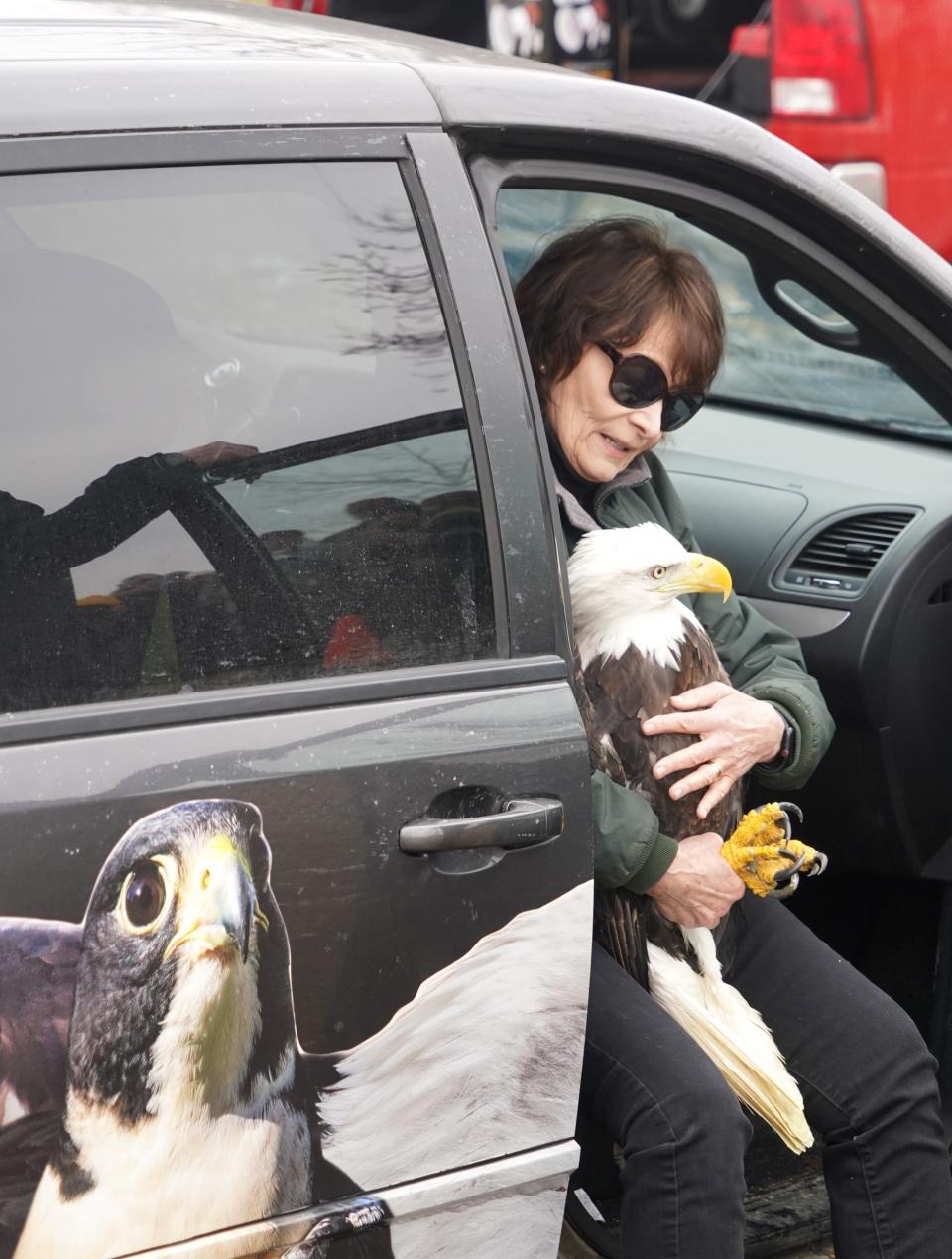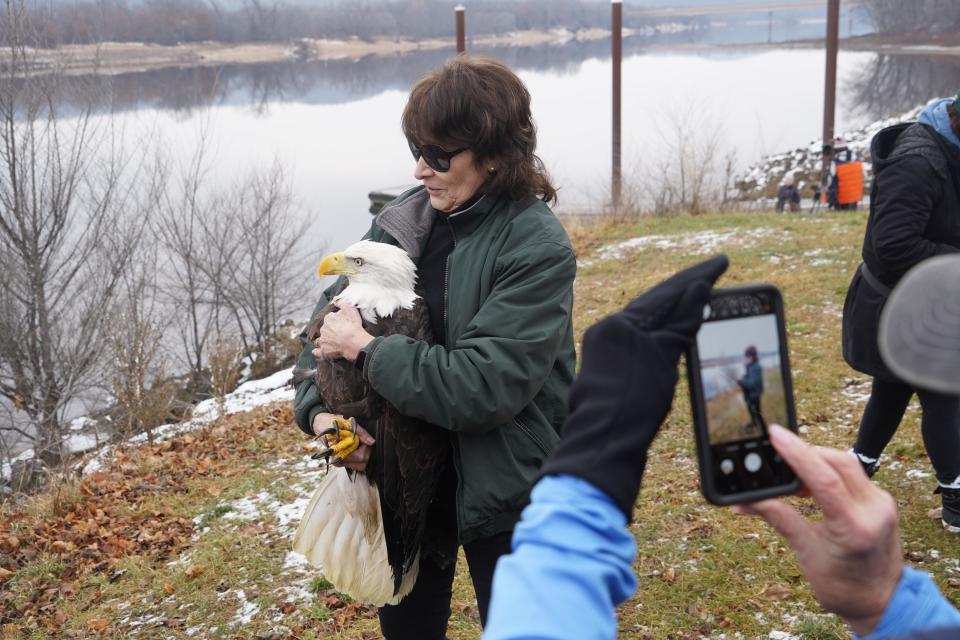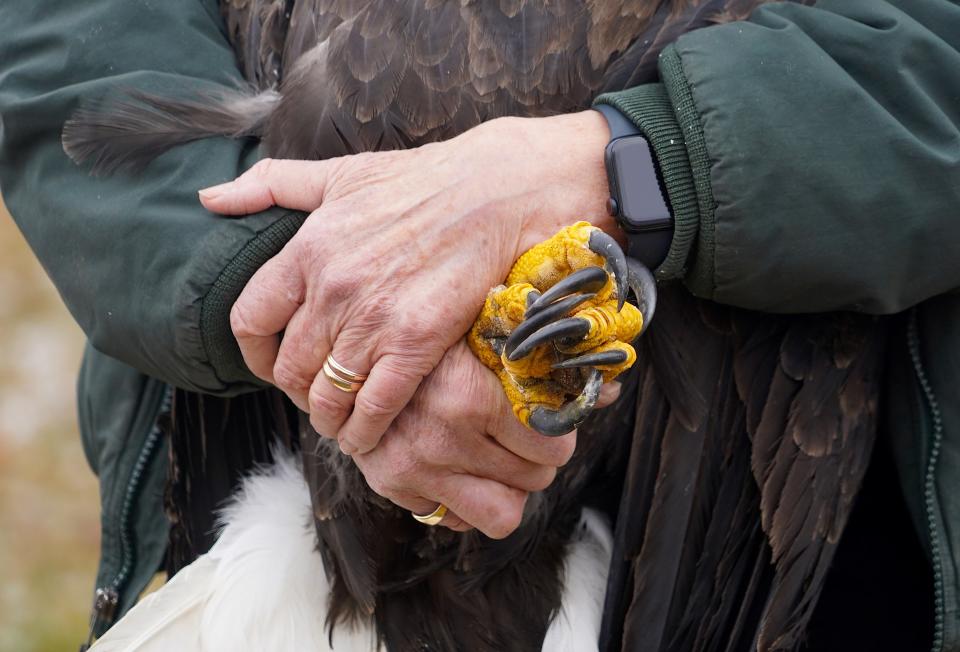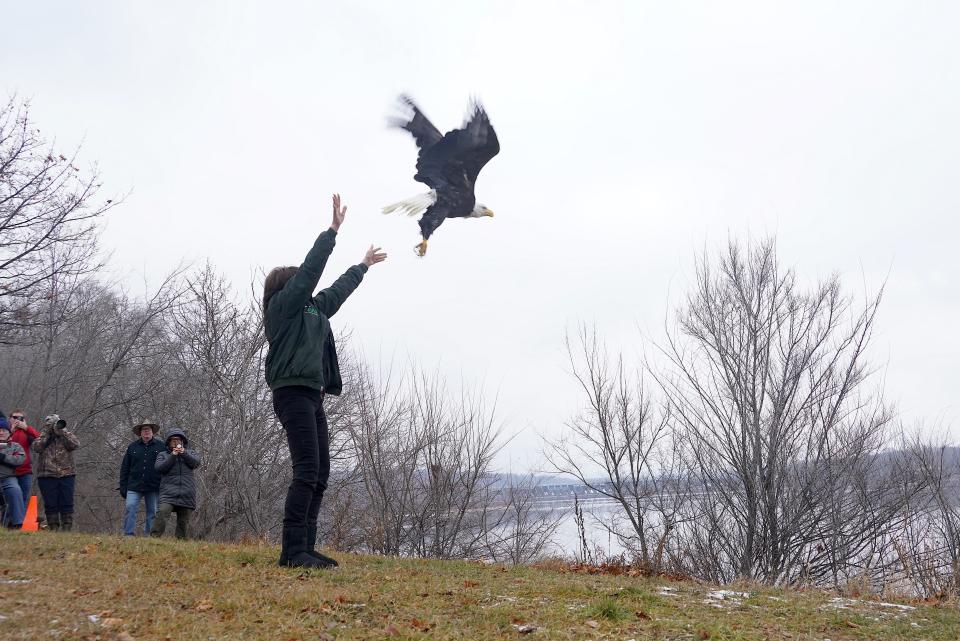Smith: Marge Gibson and REGI show the full measure of devotion to bald eagles, other birds
PRAIRIE DU SAC - A crowd of about 200 people gathered last Saturday and stood quietly on the shoulder of the Wisconsin River in Prairie du Sac's VFW Park.
Under a woolen sky, they huddled patiently for a precious visit from Wisconsin stars that promised to inject the raw, dreary day with light and hope.
At 1:20 p.m. a direct transit from Antigo arrived. It was exactly what they were waiting for.
"She's here!" said Shara Simkins of Stevens Point, standing on tip-toes to see a raptor-wrapped minivan rolling to a stop above the boat landing.
The vehicle was accented with high-definition color images of a turkey vulture, peregrine falcon, barn owl, great-horned owl, American kestrel and, toward the front doors, a bald eagle.
And sitting in the front passenger seat was "she," Marge Gibson, co-founder and executive director of Raptor Education Group, Inc., a wildlife rehabilitation center in Antigo.

Gibson is well-known in Wisconsin and beyond for her work, perhaps especially with eagles and other birds of prey and for her release of rehabilitated eagles at Prairie du Sac, sometimes in conjunction with Bald Eagle Watching Days.
Since she and her husband Don established REGI in 1990, Gibson has released about 1,200 rehabilitated eagles in Wisconsin.
This Jan. 6 visit wasn't part of an official event. But a couple hundred people showed up, many on just hours notice, as word spread through mostly informal chains of communication.
Gibson hadn't come alone, either. In addition to several REGI staff and volunteers, she traveled to Prairie du Sac with three bald eagles.
The birds had been admitted to REGI in previous months for treatment of broken bones, lead poisoning and fishing line entanglement.
This day would mark the last of their rehab. The wild awaited.
And so did the crowd.
An audible "oh!" spread as people noticed Gibson held one of the eagles in her lap.
The bird, a mature female, slowly turned its white-plumaged head and assessed the environment on the other side of the glass.
In the experienced grasp of a woman who helped nurse it back to health, it showed no distress, no anxiety. Just a serene calmness and confidence.
As some in the crowd shifted toward the vehicle, the make-shift security detail was less relaxed.
"OK, we're going to keep this area clear, so you'll have to stay back," said Randy Jurewicz, a retired Department of Natural Resources wildlife biologist who now volunteers with the Ferry Bluff Eagle Council. The council, sponsor of the community's Bald Eagle Watching Days, supplied volunteers to assist with crowd control for the eagle releases.
With a path open, Gibson stood, eagle clutched to her chest, and slowly walked into a cleared, grassy patch overlooking the river.
"Isn't she beautiful?" Gibson said as she displayed the bird about 10 feet from the line of admirers.
Her question was the epitome of "rhetorical."

With white on head and tail, chocolate brown plumage on its body, a yellow beak, yellow feet, black talons and clear, piercing eyes, the eagle was indeed a sight to behold.
And large, too. Bald eagles have bodies that measure about 3.5 feet from beak to tail and wings that span about 7 feet.
"It's as close as most people will ever get to a live eagle," Gibson said of her releases. "It may only be for a few seconds, but it can make a big impression."
She slowly walked around the inner edge of the crowd, allowing people to soak in the unique experience and take photos.
Gibson was raised in Antigo and always loved birds. In fact, according to her family lore, "birdie" is the first word she spoke.
She earned a college degree in medical technology and moved to California where she met and married Don, a pathologist, when the two worked for the same hospital in Orange County. But since a rule prohibited spouses from being employed at the same facility, Marge left human health care and put her full professional focus on birds.
That included California condors and golden eagles in California, and later bald eagles in Alaska where she helped in the wake of the Exxon Valdez spill.
It turned to all manner of wild birds in 1990 when the Gibsons moved to Antigo to help her aging parents and establish REGI.
The facility holds permits from the State of Wisconsin and the U.S. Fish and Wildlife Service to possess threatened and endangered indigenous species for rehabilitation and educational purposes.
It is also a member of the International Wildlife Rehabilitation Council, National Wildlife Rehabilitators Association, Raptor Research Foundation and American Society of Ornithology.

Raptor Education Group, Inc. cares for about 1,000 birds each year, ranging from hummingbirds to tundra swans.
The 501(c)3 non-profit organization receives no state or federal funding. It has four staff members who work with birds and two volunteers who come in during the week, Gibson said.
In 2023 it took in 854 birds, according to REGI's annual report. Two-hundred thirty-one (27%) were able to be released.
The cases run the gamut, including birds struck by vehicles, shot by poachers or thrill killers, suffering from lead poisoning and sickened by rat poison or other toxins.
January often features many eagles submitted with lead poisoning, Gibson said. Almost all are linked to the birds consuming lead bullet fragments as they scavenge deer gut piles or unrecovered deer on the landscape.
"In the wake of every gun deer season we get another spike in eagles with lead poisoning," Gibson said. "It would be such an easy issue to solve if all hunters would use copper or other non-toxic bullets."
Through the first 10 days of the new year, REGI admitted 15 new bird patients. The birds included three bald eagles, two suffering from lead poisoning and one which had been shot.
The facility uses adult bald eagles and adult trumpeter swans which can't be released to serve as foster parents to young of their own species in treatment.
In this way, the young birds don't imprint on humans and are better able to resume life in the wild, Gibson said.
The facility includes a 110-foot-long, 28-foot-high indoor flight room used to exercise eagles. Remote cameras allow REGI staff to monitor the progress of the patients.
"It's so important for their recoveries," Gibson said. "We watch how well they can fly, how well they can turn. It gets them in great condition."
Bald eagles are generally doing well in Wisconsin. In 2022 the species was documented nesting in Milwaukee County, a milestone marking nesting in all 72 Wisconsin counties for the first time in more than 100 years.
But with a higher population also comes increased numbers of sick and injured eagles, Gibson said.
REGI has had as many as 32 eagles in its care at once.

And in a worrying trend, Gibson said REGI's rehabilitation success rate is down in recent years due to more serious cases of illegal shootings and critical cases of lead poisoning.
"It is hard to look an eagle in the face and apologize for my species," Gibson said. "These are perfect specimens that should not be dying or needing treatment if it wasn't for a human-caused affliction."
That's where the "education" part of REGI kicks in. Gibson uses public appearances to help inform people about the leading concerns facing raptors as well as help garner more support for wildlife.
The second part comes naturally. As Gibson carried the adult female eagle around, the crowd murmured with delight.
The bird had a regal presence. No one at the gathering doubted why this country's founders chose the species as the nation's symbol. Or why Ojibwe tribes have Eagle clans.
After giving the crowd 15 minutes of close-up eagle time, it was time to give the eagle what it deserved - freedom.
The adult female was found in November in Plover with a broken wing. But its hollow bones healed well and "she exercised like a fiend," Gibson said. A brood patch on the bird's chest indicated it likely had young last year. And those birds, and the mate, were likely out there.
This girl was ready to fly into the wild and find its family.
Gibson moved to a clearing on the lip of the riverbank and began a slow count to three. Then, with both hands, she boosted the bird into the air.
In a flurry of wings, the eagle gathered its balance and flew east. In 30 seconds it was across the Wisconsin River and perched in a tall tree along with several other eagles.

A spontaneous applause rippled through the crowd.
In the next 10 minutes the other two eagles, both adolescents, were released from crates. One had been admitted with lead poisoning, the other after its wing had gotten wrapped with fishing line, rendering it flightless.
Both flew off strongly when the doors of their carriers were opened. They, too, eventually joined the eagles on the other side of the river.
"I know they are beautiful up close," Gibson said. "But the best sight of all is when they fly back into the wild."
To donate to or learn more about REGI, visit raptoreducationgroup.org or its Facebook page.
This article originally appeared on Milwaukee Journal Sentinel: Marge Gibson and REGI show the full measure of devotion to wild birds

